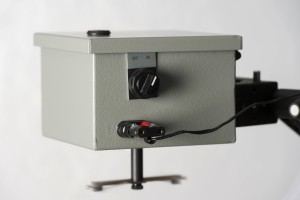Rotation Impaction Technology
The GRIPST series samplers from Aerobiology Research Laboratories are less expensive and less labour intensive.
In most instances it is necessary to collect samples over long periods of time. This poses a problem of rod overload: if too many particles are collected on the rods, the sample will be difficult, if not impossible, to accurately analyze. When long collection periods are required, it is recommended that the collection be made intermittently over the sampling period, using a reduced duty cycle. Standard practice in aerobiology is to sample a 24-hour period using a 10% duty cycle (one minute of sampling, nine minutes of rest), thus providing an even sampling of particles over the course of a day without overloading the rods’ surface. The GRIPST series samplers from Aerobiology Research Laboratories have integrated timers that provide the capability of sampling with reduced duty cycles.
that provide the capability of sampling with reduced duty cycles.
Aerobiology Research Laboratories supplies sampling heads that are auto-retracting. The rods are contained inside of the sampling head while at rest, and during sampling are extended downwards at 90° to the sampling head by centrifugal force. Retracting the rods while the sampler is at rest protects them from unmetered particle impaction as well as from the elements.
Rotation impaction samplers are non-selective, meaning that they will collect all airborne particles including debris. This should be an important consideration when determining the period and duration of sampling, as well as the duty cycle. These samplers are also capable of sampling for only one duration at a time, at which point the rods must be switched before a second sample can be obtained. Arrays of multiple samplers are often used in combination with a switching power supply when more than one sample is required for a given duration.
Other sampling methods and equipment are being used in this industry, but these are more labour intensive and are costly to buy. These are based on suction sampling and are highly affected by wind speed and direction (Manual for Sampling Airborne Pollen, E.C. Ogden, et al.). Some suction samplers have the ability to shift their collection surface, so that the sample can be sub-sectioned into hourly or daily increments — an advantage over rotation impaction samplers. However, the equipment is highly susceptible to human error in configuration of the sampler, in changing of the samples, and when analysis and interpreting results. Aerobiology Research Laboratories has researched sampling and analysis methodologies with the objectives of reproducibility and accuracy, and has found that there is no standardization of methods to analyze samples for suction type machines so there is no standardized data like there is for our rotation impaction samplers.
Research has been performed over the years comparing different types of samplers and their respective results. As of yet very little research has been published on how representative each of these different types of samplers are in what they collect compared to what is actually in the air. Our research, using the collections of the different samplers with a constant known amount of particles of varying sizes has shown that the calibration of suction samplers significantly affects the rate at which particular sizes of particles are collected. Samplers calibrated for larger particles (pollen) results in an oversampling of smaller particles (spores). When sampling in the field, it is often difficult to know how each piece of equipment is maintained and used, and therefore it is very difficult to tell from day to day if the sampler is even functioning as expected. The complexity and reliability of the equipment used, the amount of training provided to the operator, and the methodology and abilities of personnel involved in analysis all affect the validity of the data. More relevant research has to be done to compare different types of samplers to know what each is actually collecting.
